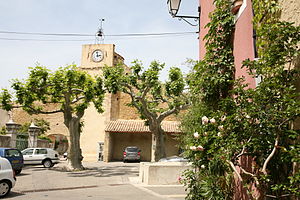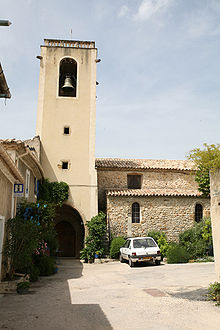Buisson
| Buisson | ||
|---|---|---|

|
|
|
| region | Provence-Alpes-Cote d'Azur | |
| Department | Vaucluse | |
| Arrondissement | Carpentras | |
| Canton | Vaison-la-Romaine | |
| Community association | Vaison Ventoux | |
| Coordinates | 44 ° 17 ′ N , 5 ° 0 ′ E | |
| height | 156-395 m | |
| surface | 9.49 km 2 | |
| Residents | 298 (January 1, 2017) | |
| Population density | 31 inhabitants / km 2 | |
| Post Code | 84110 | |
| INSEE code | 84022 | |
 Village square with clock tower |
||
Buisson is a French municipality with 298 inhabitants (at January 1, 2017) in the Vaucluse department in the region of Provence-Alpes-Cote d'Azur . It belongs to the canton of Vaison-la-Romaine in the Arrondissement of Carpentras .
geography
Buisson is located approximately eight kilometers northwest of Vaison-la-Romaine . The municipality is bounded to the north by the River Eygues , which also forms the border with the Drôme department . Other surrounding communities besides Vaison are Villedieu , Roaix , Rasteau and Saint-Roman-de-Malegarde in Vaucluse, and Saint-Maurice-sur-Eygues and Tulette in Drôme. The nearest major cities are Valréas in the north (twelve kilometers), Bollène in the west (20 kilometers) and Orange in the southwest (22 kilometers away).
traffic
The department road D20 crosses the commune from Vaison-la-Romaine in a north-west direction and meets the D94 after the bridge over the Eygues. The D20 is crossed in Buisson by the D51, which leads in a south-westerly direction to Cairanne and in a north-easterly direction to Villedieu.
A few kilometers to the northwest is the small Valréas-Visan airfield .
history
Because of its favorable geographical location, Templars from Roaix founded a commandery in 1137 , in which some soldier monks lived. In 1320 the fiefdom passed into papal ownership and belonged to various landlords in the 16th century . During the Huguenot Wars , Protestants from Nyons invaded the village and stole the church bell , which they only brought back a hundred years later.
The place name is perhaps derived from the late Latin word boscus , which denotes a forest or a copse . Celtologists, however, tend to assume a name after the local deity Buxenus ( Campus Buxenos ).
Population development
| year | 1962 | 1968 | 1975 | 1982 | 1990 | 1999 | 2008 | 2016 |
|---|---|---|---|---|---|---|---|---|
| Residents | 217 | 181 | 148 | 166 | 195 | 264 | 302 | 297 |
Attractions
Despite the destruction caused by the French Revolution , some ruins of the castle from the 13th century are still detectable.
According to the local archives, the city wall, built of pebbles from the Eygues , dates back to 1590. It has only a single fortified gate with a portcullis and an ocher red papal coat of arms. One of the towers was built in the 18th century to allow the installation of a tower clock .
The parish church with Romanesque origin appears in a document from 1200 under the name Notre-Dame des Bois . It has been restored and rebuilt several times and has a bell tower from the 12th century, as well as side chapels and a choir apse from the 17th century.
The Notre Dame d'Argelier chapel, reconstructed in 1874, is still a place of pilgrimage . Outside the village there are two small abandoned chapels: the Chapelle des Pénitents blancs or Chapelle Saint Joseph and the Chapelle Saint-Pierre, which dates back to the 17th century and was restored in 1755 .
literature
- Jules Courtet: Dictionnaire géographique, géologique, historique, archéologique et biographique du département du Vaucluse . Avignon 1876.
- Robert Bailly: Dictionnaire des communes du Vaucluse . A. Barthélemy, Avignon 1986.
Web links
Individual evidence
- ↑ The community on annuaire-mairie.fr
- ↑ a b c Buisson on vaison-ventoux-tourisme.com. Retrieved January 8, 2012 (French).
- ^ Albert Dauzat and Charles Rostaing : Dictionnaire étymologique des noms de lieux en France . Larousse, 1968, p. 1721 .
- ↑ Helmut Birkhan : Celts. Attempt at a complete representation of their culture. Publishing house of the Austrian Academy of Sciences, Vienna 1997, ISBN 3-7001-2609-3 , p. 650.
- ^ Pauly / Wissowa: Paulys Real-Encyclopädie der classischen Altertumswwissenschaft, Volume 14, JB Metzler, 1930, p. Viii.


